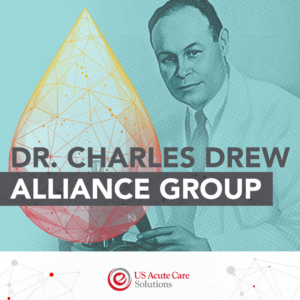USACS Introduces the Dr. Charles Drew Alliance Employee Resource Group

“In my role as Chief of Clinician Engagement, it is important for me to find ways to connect and engage with physicians, APPs, and MSO members,” said Dr. Kendall. “Connecting with those who can relate to your experience is invaluable and helps build a deeper sense of community.”
Since the inception of the new ERGs last summer, some have crafted meaningful names to reflect the groups they represent. For the Dr. Charles Drew Alliance Resource Group, formerly the USACS Black Resource Group, its leaders focused on finding a name to honor and embody the Black experience as it pertains to medicine.
“We wanted to pinpoint a notable Black clinician who was able to overcome obstacles during their career and whose story reveals the struggles and adversity Black clinicians and professionals often face,” said Jason Bolden, MD, FACEP, CDP, Medical Director and leader of the Dr. Charles Drew Alliance Resource Group. “Dr. Charles Richard Drew fit our criteria, making him the perfect candidate to honor as we selected our group’s name.”
Dr. Charles Richard Drew was a surgeon known for his research and innovations encompassing transfusions, fluid resuscitation, and, most notably, blood banking. As one of 13 Black students in a student body of 600 at Amherst College in Massachusetts, Dr. Drew faced many challenges during his studies as segregation rules and laws narrowed his opportunities. Given these limitations in the United States, Dr. Drew enrolled at the McGill University College of Medicine in Montreal where he graduated second in his class in 1933. During his surgical residency, Dr. Drew sparked an interest in transfusions and fluid resuscitation which became the foundation of his life’s work.
After being denied the opportunity to continue his research at the Mayo Clinic due to his race, Dr. Drew became a professor at Howard University College of Medicine and enrolled at Columbia University to earn his doctorate. In 1938, Dr. Drew presented his thesis, “Banked Blood: A Study in Blood Preservation,” which made him the first Black person to earn a medical science doctorate from the prestigious institution. This profound research led Dr. Drew to be named the supervisor of the Blood for Britain Project during World War II.
Although Dr. Drew’s research and initiatives were being used on a large scale with the American Red Cross implementing blood banking and adapting their blood preservation and storage techniques to reflect his findings, it did not negate the reality of segregation limitations as Dr. Drew’s own blood was not accepted due to his race. This medically unsupported rationale did not deter Dr. Drew from persevering as he continued his efforts to enhance the research and implementation of blood preservation and transfusions. To this day, Dr. Drew’s contributions to the field of medicine are widely recognized and utilized across all specialties.
The journey of Dr. Drew’s career as a Black surgeon, academic leader, and research pioneer during a time in our history when the odds were stacked against him made him the perfect candidate to be selected as the honoree of the group’s name.
“Dr. Charles Richard Drew’s journey embodies the spirit, resilience, and excellence of the Black experience, which aligns with the efforts of our resource group,” said Dr. Bolden. “We hope this group provides members of the Black community within our organization a platform for their voices to be heard. We value their experiences and will advocate for change on their behalf.”
Still in its infancy, The Dr. Charles Drew Alliance Employee Resource Group is finding its footing and hopes to engage in productive conversations with those interested in joining.
“There are a lot of stressors in our society due to the spread of misinformation and how people are perceived,” said Dr. Bolden. “We want to dispel any negative aspects surrounding those issues by providing solutions and resources for our members.”
As each of the employee resource groups grows and develops, Dr. Kendall encourages all USACS team members to join any group they feel drawn toward as there are no strings attached to membership.
“Membership in one of our resource groups does not require any attendance or participation minimums,” remarked Dr. Kendall. “We emphasize member flexibility through scheduling varying meeting times to accommodate differing schedules, sending meeting notes and minutes to recap for those who couldn’t attend, and providing resources for anyone who raises their hand as an interested employee.”
Dr. Kendall continued, “If you feel connected at work and are engaged in these types of meetings and activities, you are more likely to stay with the organization long-term and will experience less burnout. We want to ensure our physicians, APPs, and MSO employees are happy with their work so they may continue to impact and serve our patients positively.”
To learn more about our employee resource groups, visit The Central Line and connect with one of the leaders to become a member.

